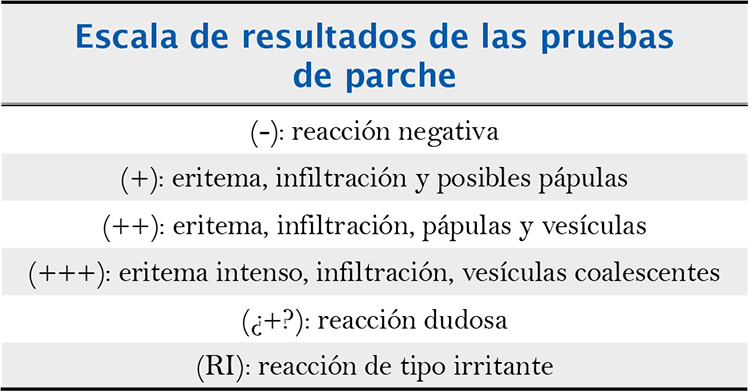Descriptive study of contact dermatitis to cosmetics. Medellin, Colombia.
Abstract
Introduction: Contact dermatitis to cosmetics is a common problem in the general population, although its prevalence appears to be underestimated.
Objectives: We sought to describe the clinical characteristics of patients with cosmetic contact allergy, to identify the culprit allergens, the frequency of the sensitivities, and the cosmetic products implicated.
Methods: We performed an observational, descriptive, retro-prospective study in patients with clinical signs of cosmetic contact allergy, who were referred to our clinic for patch test in the last eight years and nine months.
Results: Patch tests were carried out in 187 patients, of whom 145 were diagnosed with allergic contact dermatitis to an allergen from cosmetic sources (141 women and 4 men). A total of 387 positive allergens were found. Allergens most often implicated were: nickel sulphate (40.5%); cobalt chloride (20.08%); thimerosal (15.33%); toluene sulfonamide formaldehyde resin (13.89%); balsam of Perú (9.19%), and fragrance mix (7.56%). The cosmetic products most often implicated among cosmetic users were eye mascara/eye liners in 25%, facial creams in 9.72% and perfumes in 8.3% of patients. Two hundred and thirty (59.4%) positive allergens were detected with the standard battery, 107 (27.6%) with the cosmetic battery, and 50 (12.9%) with patients products.
Conclusion: Contact allergy to cosmetics is very prevalent in the context of high clinical suspicion. Standard battery is insufficient to detect all the positive cases. In this sense, is very important to perform patch tests also with specific cosmetic battery and with patient’s products.
Author Biographies
Ana María Rivas
Residente de Dermatología, Facultad de Medicina, Escuela de Ciencias de la Salud, Universidad Pontificia Bolivariana, Medellín, Colombia
Jon Kepa
Estudiante de pregrado, Facultad de Medicina, Escuela de Ciencias de la Salud, Universidad Pontificia Bolivariana, Medellín
María Elizabeth Gaviria
Estudiante de pregrado, Facultad de Medicina, Escuela de Ciencias de la Salud, Universidad Pontificia Bolivariana, Medellín
Rodrigo Nuñez
Dermatólogo docente, Universidad Pontificia Bolivariana, Medellín, Colombia
References
2. Giménez JM. Dermatitis de contacto. Madrid: Grupo Aula Médica; 1999. p. 31-59.
3. De Groot AC. Contact allergy to cosmetics: Causative ingredients. Contact Dermatitis.1987;17:26-34.
4. Tomar J, Jain VK, Aggarwal K, Dayal S, Gupta S. Contact allergies to cosmetics: Testing with 52 cosmetic ingredients and personal products. J Dermatol. 2005;32:951-5.
5. Orton DI, Wilkinson JD. Cosmetic allergy: Incidence, diagnosis, and management. Am J Clin Dermatol. 2004;5:327-37.
6. Willis CM, Shaw S, De Lacharriere O, Baverel M, Reiche L, Jourdain R, et al. Sensitive skin: An epidemiological study. Br J Dermatol. 2001;145:258-63.
7. Duarte I, Campos AC. Frequency of dermatoses associated with cosmetics. Contact Dermatitis. 2007;56:211-3.
8. Lindberg M, Tammela M, Boström A, Fischer T, Inerot A, Sundberg K, et al. Are adverse skin reactions to cosmetics underestimated in the clinical assessment of contact dermatitis? A prospective study among 1,075 patients attending Swedish patch test clinics. Acta Derm Venereol. 2004;84:291-5.
9. Biebl K, Washaw EM. Allergic contact dermatitis from cosmetics. Dermatol Clin. 2006;24:215-32.
10. Warshaw EM, Buchholz HJ, Belsito DV, Maibach HI, Fowler JF Jr, Rietschel RL, et al. Allergic patch test reactions associated with cosmetics: Retrospective analysis of crosssectional data from the North American Contact Dermatitis Group, 2001-2004. J Am Acad Dermatol. 2009;60:23-38.
11. Berne B, Tammela M, Färm G, Inerot A, Lindberg M. Can the reporting of adverse skin reactions to cosmetics be improved? A prospective clinical study using a structured protocol. Contact Dermatitis. 2008;58:223-7.
12. Bordel-Gómez MT, Miranda-Romero A, Castrodeza-Sanz J. Epidemiology of contact dermatitis: Prevalence of sensitization to different allergens and associated factors. Actas Dermosifiliogr. 2010;101:59-75.
13. Makela L, Lammintausta K, Kalimo K. Contact sensitivity and atopic dermatitis: Association with prognosis, a follow-up study in 801 atopic patients. Contact Dermatitis. 2007;56:76-80.
14. Breithaupt A, Jacob SE. Thimerosal and the relevance of patch-test reactions in children. Dermatitis. 2008;19:275-7.
15. Toro AM, Núñez R. Dermatitis alérgica de contacto a la resina toluen sulfonamida formaldehido. Rev Asoc Colomb Dermatol. 2009;17:230-2.
16. Eiermann HJ, Larsen W, Maibach HI, Taylor JS. Prospective study of cosmetic reactions: 1977-1980. North American Contact Dermatitis Group. J Am Acad Dermatol. 1982;6:909-17.
17. Laguna C, de la Cuadra J, Martín-González B, Zaragoza V, Martínez-Casimiro L, Alegre V. Allergic contact dermatitis to cosmetics. Actas Dermosifiliogr. 2009;100:53-60.
18. Kohl L, Blondeel A, Son M. Allergic contact dermatitis from cosmetics: Retrospective analysis of 819 patch tested patients. Dermatology. 2002;204:334-7.
19. García-Melgares ML, de la Cuadra J, Martín B, Laguna C, Martínez L, Alegre V. Sensitization to gallates: Review of 46 cases. Actas Dermosifiliogr. 2007;98:688-93.
20. Marston S. Propyl gallate on liposomes. Contact Dermatitis. 1992;27:74-6.
21. Perez A, Basketter DA, White IR, McFadden J. Positive rates to propyl gallate on patch testing: A change in trend. Contact Dermatitis. 2008;58:47-8.
22. Bordel-Gómez MT, Miranda-Romero A. Contact sensitization to Euxyl K-400. Actas Dermosifiliogr. 2009;100:201-4.
23. de Groot A, White IR, Flyvholm MA, Lensen G, Coenraads PJ. Formaldehyde-releasers in cosmetics: Relationship to formaldehyde contact allergy. Contact Dermatitis. 2010;62:2-31.
How to Cite
Downloads

Downloads
Published
How to Cite
Issue
Section
| Article metrics | |
|---|---|
| Abstract views | |
| Galley vies | |
| PDF Views | |
| HTML views | |
| Other views | |






